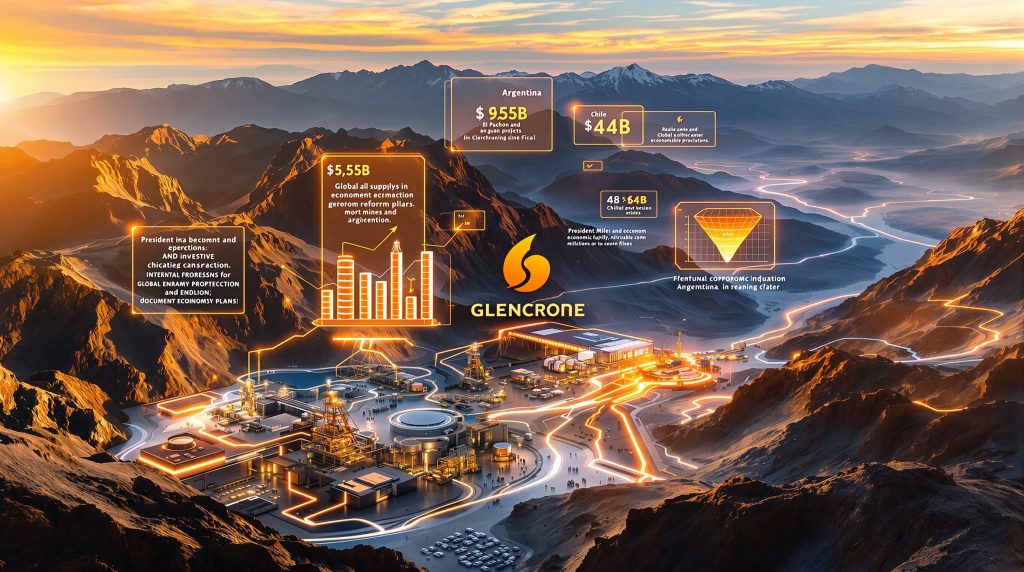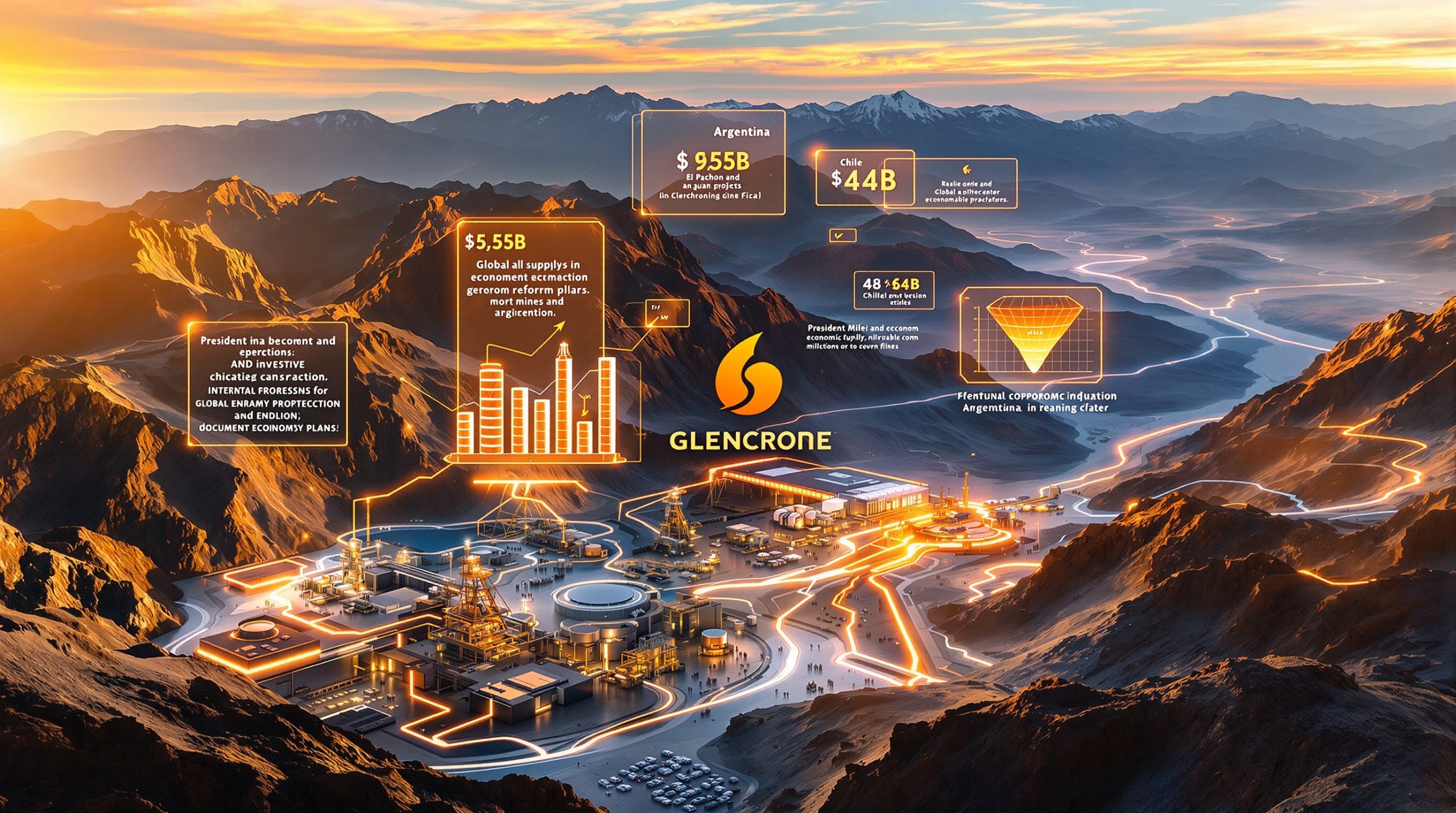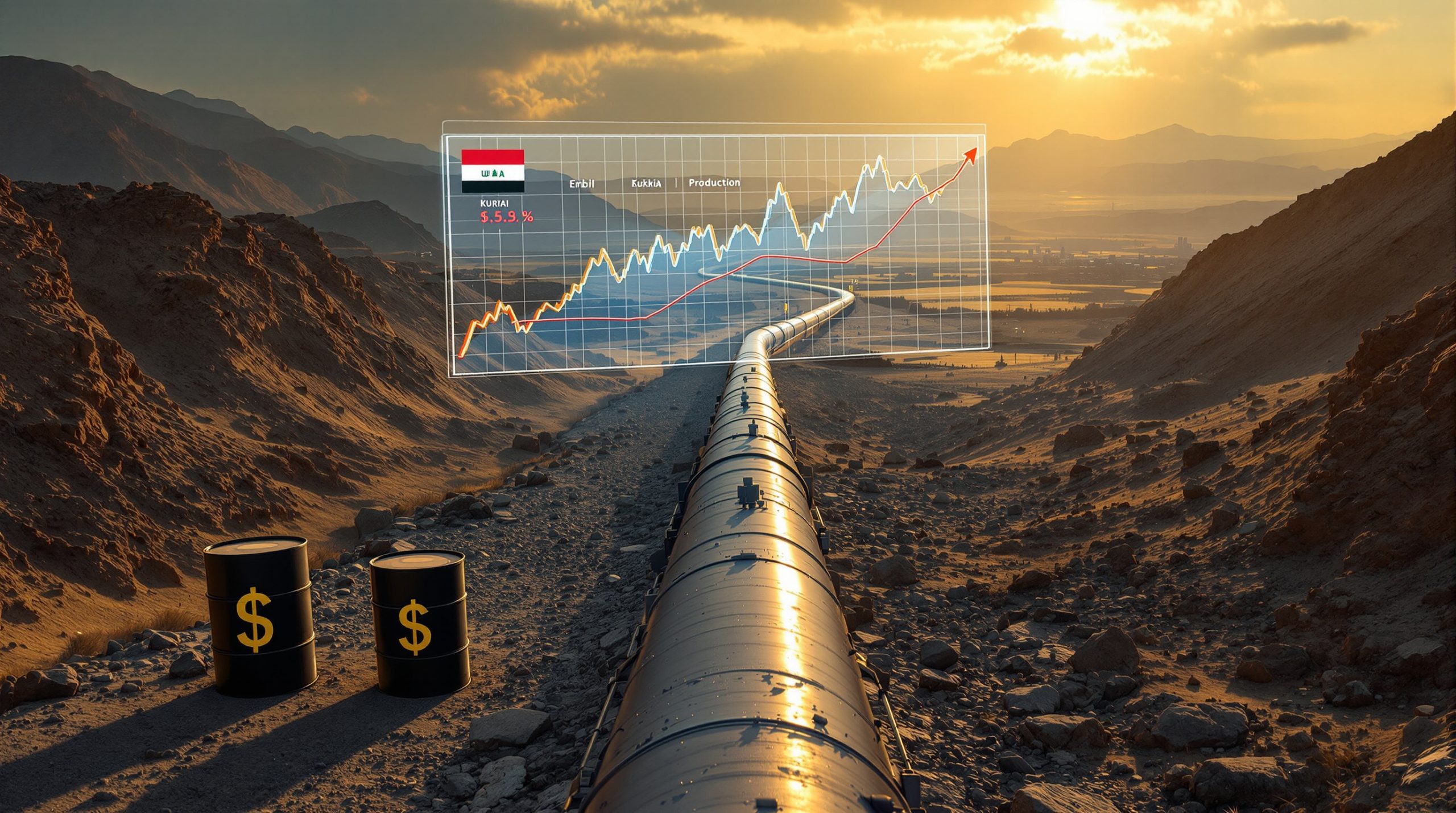Glencore Seeks $13 Billion in Incentives for Argentina Copper Projects
Argentina, long known for its agricultural prowess and oil production, is rapidly emerging as a significant player in the global copper mining industry. The recent applications filed by Glencore for two major copper projects highlight this transformation, potentially reshaping both Argentina's economic landscape and the global copper supply chain.
Argentina's Copper Investment Landscape Transformation
Argentina's mining sector is experiencing a remarkable evolution under President Javier Milei's administration. Once considered an investment pariah due to economic instability and restrictive policies, the country is now positioning itself as an emerging copper hub, particularly in the San Juan province.
President Milei's economic reforms have created a new investment climate that is attracting significant foreign interest. These reforms include the introduction of the RIGI (Régimen de Incentivo a las Grandes Inversiones) program, which offers substantial benefits to large-scale investors, particularly in the mining sector.
The Rise of Argentina as a Copper Destination
San Juan province has emerged as a strategic copper mining center, challenging the traditional dominance of neighboring Chile and Peru in South American copper production. The province's geological potential, coupled with the new economic framework, has created a perfect storm for mining industry evolution.
"This framework has changed the investment landscape in Argentina, providing a key catalyst to attract major foreign investment to the country," stated Gary Nagle, Glencore's CEO, highlighting the transformation underway in Argentina's mining sector.
While Argentina has historically focused on farming and oil production, the country is now actively diversifying its economic base, recognizing the strategic importance of metals like copper in the global energy transition.
Understanding Argentina's RIGI Investment Framework
The RIGI program offers three primary advantages to investors:
- Tax incentives: Reduced tax burden for qualifying large-scale investments
- Customs advantages: Simplified import procedures for equipment and technology
- Currency exchange privileges: Greater flexibility in managing foreign currency, a significant benefit in Argentina's historically volatile economic environment
These incentives have already attracted substantial interest from international mining companies. According to Economy Minister Luis Caputo, the RIGI program has received applications for 20 projects valued at $33.6 billion as of August 2023.
The program is specifically designed to protect capital commitments in Argentina's historically unstable economic environment, providing investors with greater certainty and reduced risk exposure. This approach marks a significant departure from previous government policies that often deterred foreign investment.
What Are Glencore's Specific Investment Plans?
Glencore's applications under the RIGI program encompass two major copper projects: El Pachon and Agua Rica, with a combined investment of $13.5 billion. These projects represent a significant commitment to Argentina's emerging copper sector.
El Pachon Project Overview
The El Pachon copper project is located in Argentina's San Juan province, near the Chilean border. This strategic location offers advantages in terms of infrastructure and potential synergies with existing mining operations in the region.
Key project details include:
- Investment: $9.5 billion estimated capital expenditure
- Location: San Juan province, Argentina
- Status: Application filed under RIGI program
El Pachon is of particular interest to the global copper market given its scale and proximity to established mining infrastructure. The project represents one of the largest undeveloped copper deposits in South America and could significantly impact global copper project insights when operational.
The development timeline and production potential remain under assessment, but industry analysts suggest the project could produce hundreds of thousands of tonnes of copper annually once operational, helping to address the growing supply gap in global markets.
Agua Rica Project Details
The Agua Rica project represents Glencore's second major copper investment in Argentina under the RIGI program. Located in Catamarca province, this project complements the El Pachon development and further strengthens Glencore's position in Argentina's copper sector.
Project specifics include:
- Investment: $4 billion estimated capital requirement
- Location: Catamarca province, Argentina
- Status: Application filed under RIGI program
Agua Rica faces different development challenges compared to El Pachon, including more complex geology and infrastructure requirements. However, the project offers significant opportunities for regional economic development and employment creation in Catamarca province.
"Today's submission marks a significant step towards the development of El Pachon and Agua Rica," noted Gary Nagle when announcing the RIGI applications, signaling Glencore's commitment to advancing both projects.
How Does This Fit Into Argentina's Broader Mining Strategy?
Argentina's push into copper mining represents a strategic diversification of its resource sector, building on the success it has achieved in lithium production. The country has become a significant player in the global lithium market, particularly in the "Lithium Triangle" shared with Chile and Bolivia.
Argentina's Copper Ambitions
While Argentina has found success with lithium, copper mining presents different challenges and opportunities. Copper projects are typically larger, more capital-intensive, and have more significant environmental footprints than lithium operations. However, they also offer greater economic benefits in terms of job creation, infrastructure development, and tax revenue.
The Argentine government appears to be taking a coordinated approach to developing its copper sector, recognizing the need for:
- Infrastructure development to support mining operations
- Regulatory frameworks that balance environmental protection with economic development
- Policies that ensure local communities benefit from mining activities
- Investment incentives that attract foreign capital and expertise
If successful, Argentina's copper sector development could significantly boost the country's export earnings, create thousands of jobs, and establish the nation as a major player in the global metals market.
Competitive Landscape in Argentine Copper
Glencore is not alone in targeting Argentina's copper potential. Other major mining companies have also identified the country as a growth opportunity, particularly in San Juan province.
BHP Group Ltd., the world's largest mining company, has shown interest in the region, recognizing the geological potential and improving investment climate. Similarly, McEwen Copper Inc. has established a presence in Argentina's copper belt, pursuing projects that complement the larger developments planned by Glencore and others.
This competitive landscape demonstrates the growing recognition of Argentina's copper potential among global mining leaders. For Glencore, the competition presents both challenges and opportunities – driving innovation and efficiency while potentially creating synergies in infrastructure development and regulatory engagement.
What Makes These Projects Globally Significant?
The global copper market is currently facing significant supply challenges against a backdrop of rapidly growing demand. This market dynamic makes Glencore's Argentine projects particularly significant in the global context.
Global Copper Market Implications
The global copper industry is struggling to keep pace with surging copper demand driven by:
- Electrification: Copper is essential for electric vehicles, charging infrastructure, and renewable energy systems
- Urbanization: Developing economies require substantial copper for construction and infrastructure
- Digitalization: Data centers, telecommunications, and electronics all depend on copper
With copper prices hovering around $4.47 per pound as of August 2023, the market is signaling the need for new supply sources. Glencore's Argentine projects could help address this supply gap, potentially influencing copper price forecast and availability.
The timing of these projects is particularly significant, as many analysts predict a widening supply deficit in the copper market through the remainder of the decade. New production capacity from Argentina could help moderate price increases and ensure adequate supply for critical electrification initiatives worldwide.
Investment Risk Assessment
Despite the attractive market conditions, investing in Argentine mining projects carries historical risks that investors must carefully assess:
- Political stability: Argentina has experienced significant political volatility that has affected foreign investments in the past
- Economic uncertainty: Currency fluctuations, inflation, and capital controls have historically complicated mining operations in Argentina
- Regulatory changes: Mining regulations have changed frequently, creating uncertainty for long-term investments
The RIGI program attempts to mitigate these traditional risks by providing legal and financial stability for qualifying investments. Compared to mining investments in neighboring Chile and Peru, Argentine projects have historically been considered higher risk, but potentially higher reward.
The long-term viability of Glencore's projects will depend on both the company's operational execution and Argentina's ability to maintain a stable investment environment through changing political and economic conditions.
What Challenges Must Be Overcome?
Developing large-scale copper projects in Argentina presents significant challenges that must be addressed for successful implementation. These challenges span infrastructure, environmental concerns, and social considerations.
Infrastructure Requirements
Copper mining and processing require substantial infrastructure support, much of which must be developed in Argentina's emerging mining regions:
- Transportation networks: Rail, road, and port facilities to move equipment in and copper products out
- Energy supply: Reliable and affordable electricity for processing operations
- Water resources: Secure water access in often arid regions for mining and processing
- Communications: Modern telecommunications infrastructure for operational efficiency
The cost implications of this infrastructure development are substantial and must be factored into overall project economics. In some cases, mining companies may need to develop infrastructure that can later benefit local communities and other industries, creating opportunities for public-private partnerships.
Environmental and Social Considerations
Modern mining projects face rigorous environmental and social requirements, particularly in jurisdictions like Argentina that are developing their regulatory frameworks:
- Environmental impact assessments: Comprehensive studies of potential impacts on air, water, and land
- Water management: Strategies for minimizing water usage and preventing contamination
- Community engagement: Proactive dialogue with local communities to address concerns and share benefits
- Biodiversity protection: Measures to preserve local ecosystems and protect sensitive areas
Glencore and other mining companies will need to implement best-practice environmental management systems and community engagement strategies to secure their social license to operate. This approach aligns with global trends toward more sustainable and socially responsible mining practices.
What's Next for Glencore's Argentina Copper Strategy?
Glencore's applications under the RIGI program represent an important milestone in the company's Argentina strategy, but several critical steps remain before these projects move from planning to production.
Decision Timeline and Milestones
The development of El Pachon and Agua Rica will follow a structured timeline with several key decision points:
- Regulatory approval: Processing of RIGI applications and issuance of necessary permits
- Final investment decision: Board approval for full project funding after feasibility studies
- Construction phase: Multi-year building of mining and processing facilities
- Commissioning: Testing and optimization of operations
- Commercial production: Ramp-up to full operating capacity
While specific timelines haven't been publicly disclosed, large copper projects typically require 5-10 years from application to production. The actual timeline will depend on regulatory efficiency, market conditions, and Glencore's internal capital allocation decisions.
Strategic Significance for Glencore
These Argentine copper projects represent an important component of Glencore's global strategy, potentially strengthening the company's position in the copper market during a period of growing demand.
For CEO Gary Nagle, the successful development of El Pachon and Agua Rica would represent a significant achievement in reshaping Glencore's portfolio toward future-facing metals essential for the energy transition. The projects align with the company's stated goal of increasing exposure to copper, cobalt, nickel, and other metals critical for electrification.
In the broader South American context, these investments complement Glencore's existing operations in Chile, Peru, and other countries, creating operational synergies and strengthening the company's regional presence.
FAQ: Argentina Copper Investment
How does Argentina's RIGI program compare to mining incentives in other countries?
Argentina's RIGI program offers distinctive features compared to mining incentives in other jurisdictions:
- Tax stability: Protection against future tax increases for qualifying investments
- Currency flexibility: Enhanced ability to manage foreign exchange in a historically volatile currency environment
- Import benefits: Reduced duties on imported equipment and technology
Compared to Chile and Peru, Argentina's incentives are more comprehensive, reflecting the country's need to overcome historical investment barriers. Chile typically relies on its established mining tradition and stable regulatory environment rather than special incentives, while Peru offers various tax benefits but has faced political uncertainty.
The RIGI program represents Argentina's most ambitious attempt to attract mining investment, addressing the specific concerns that have historically deterred foreign companies from committing capital to Argentine projects.
What are the main risks for Glencore's investment in Argentina?
Glencore faces several significant risks in its Argentine copper investments:
- Political volatility: Future administrations could alter the investment framework
- Economic instability: Inflation, currency fluctuations, and potential capital controls
- Infrastructure limitations: Underdeveloped transportation and energy networks
- Community relations: Managing local expectations and concerns about environmental impacts
- Project execution: Technical challenges in developing large-scale mining operations
Balancing these risks against the potential rewards requires sophisticated risk management strategies, including political risk insurance, community development programs, and flexible project implementation approaches.
How will these projects impact global copper supply?
While specific production estimates haven't been publicly disclosed, projects of this scale typically add significant volumes to global copper supply:
- Large copper mines often produce 100,000-300,000 tonnes of copper annually
- Global copper market size is approximately 25 million tonnes per year
- New projects like El Pachon could represent 0.4-1.2% of global supply
The market impact will depend on the timing of production, which likely remains several years away. By the time these projects come online, growing demand from electrification may have expanded the market sufficiently to absorb the additional supply without significant price impacts.
What infrastructure investments are needed to support these projects?
Developing El Pachon and Agua Rica will require substantial infrastructure investments:
- Transportation: Roads, rail connections, and port facilities for shipping concentrate
- Power: Reliable electricity supply for processing operations
- Water: Pipeline systems and treatment facilities
- Communications: High-speed data networks for modern mining operations
These infrastructure investments represent a significant portion of the overall project costs but can also create lasting benefits for local communities and other industries in the region.
Copper's Critical Role in the Energy Transition
The development of Argentina's copper resources comes at a pivotal moment in the global transition to clean energy. Copper plays an indispensable role in this transition due to its unmatched electrical conductivity, durability, and recyclability.
Electric vehicles require approximately four times more copper than conventional vehicles, while renewable energy systems use significantly more copper than traditional power generation. This fundamental shift in energy systems is driving copper demand to unprecedented levels, making new sources of supply increasingly valuable.
For Argentina, developing a competitive copper sector represents not just an economic opportunity but a chance to contribute meaningfully to global climate goals by supplying a metal essential for reducing carbon emissions worldwide.
Building a Sustainable Mining Future in Argentina
The success of Glencore's copper projects in Argentina will ultimately depend on creating value for all stakeholders – investors, communities, government, and the environment. Modern mining approaches emphasize:
- Environmental stewardship: Minimizing ecological footprints and restoring land
- Community partnerships: Ensuring local development benefits from mining operations
- Transparency: Open communication about project impacts and benefits
- Innovation: Applying new technologies to reduce resource consumption and emissions
By applying these principles, Glencore and other mining companies can help establish Argentina as a responsible and competitive copper producer for decades to come, creating a new chapter in the country's resource development story. Furthermore, these developments could provide valuable copper investment insights for investors looking to capitalize on the growing global demand for this essential metal.
Ready to Spot the Next Major Mineral Discovery?
Don't miss potential market-moving announcements like these copper projects. Discovery Alert's proprietary Discovery IQ model delivers real-time notifications on significant ASX mineral discoveries, giving you a crucial market advantage. Explore historic returns from major discoveries at https://discoveryalert.com.au/discoveries/ and position yourself ahead of the market.




